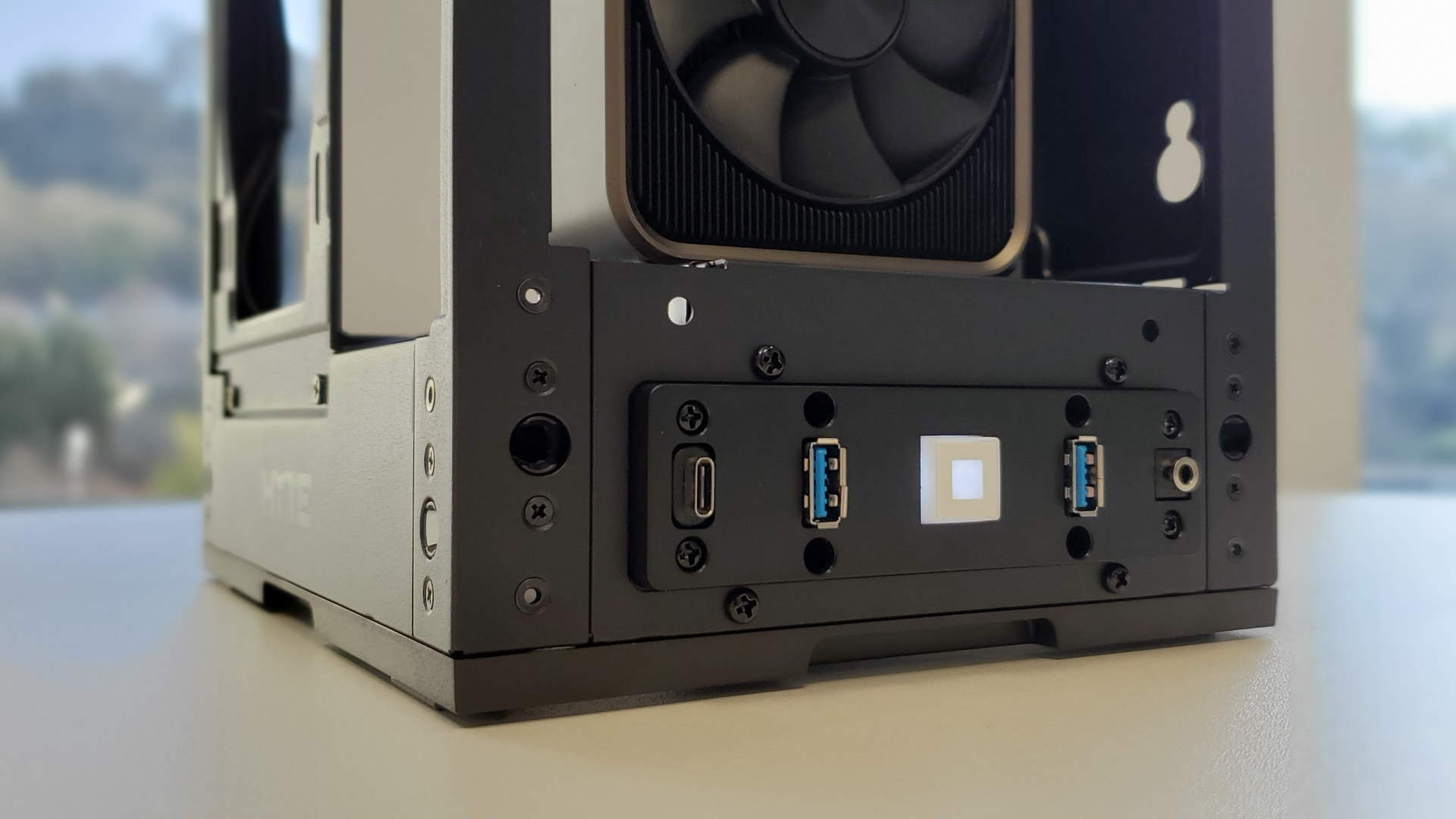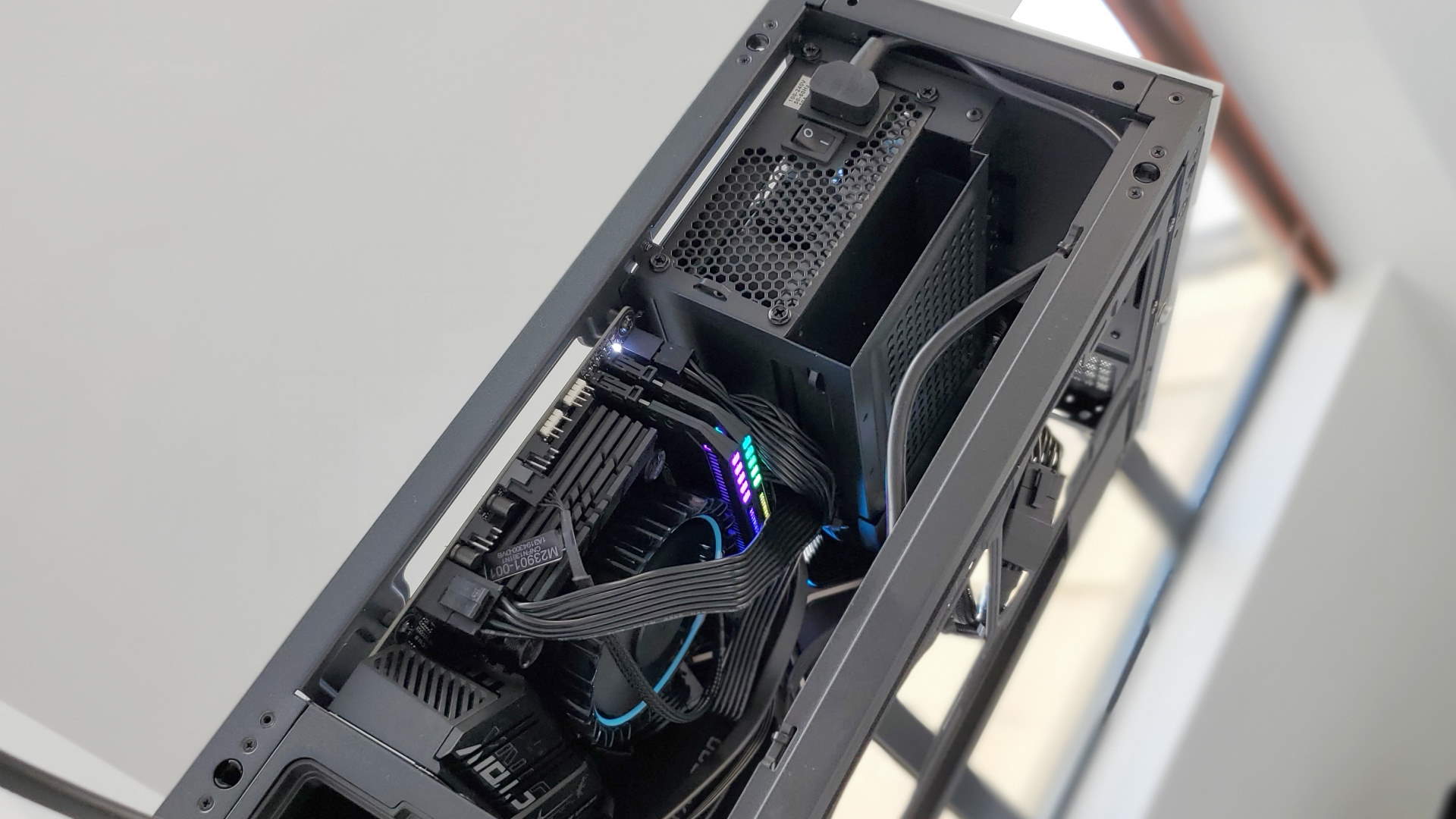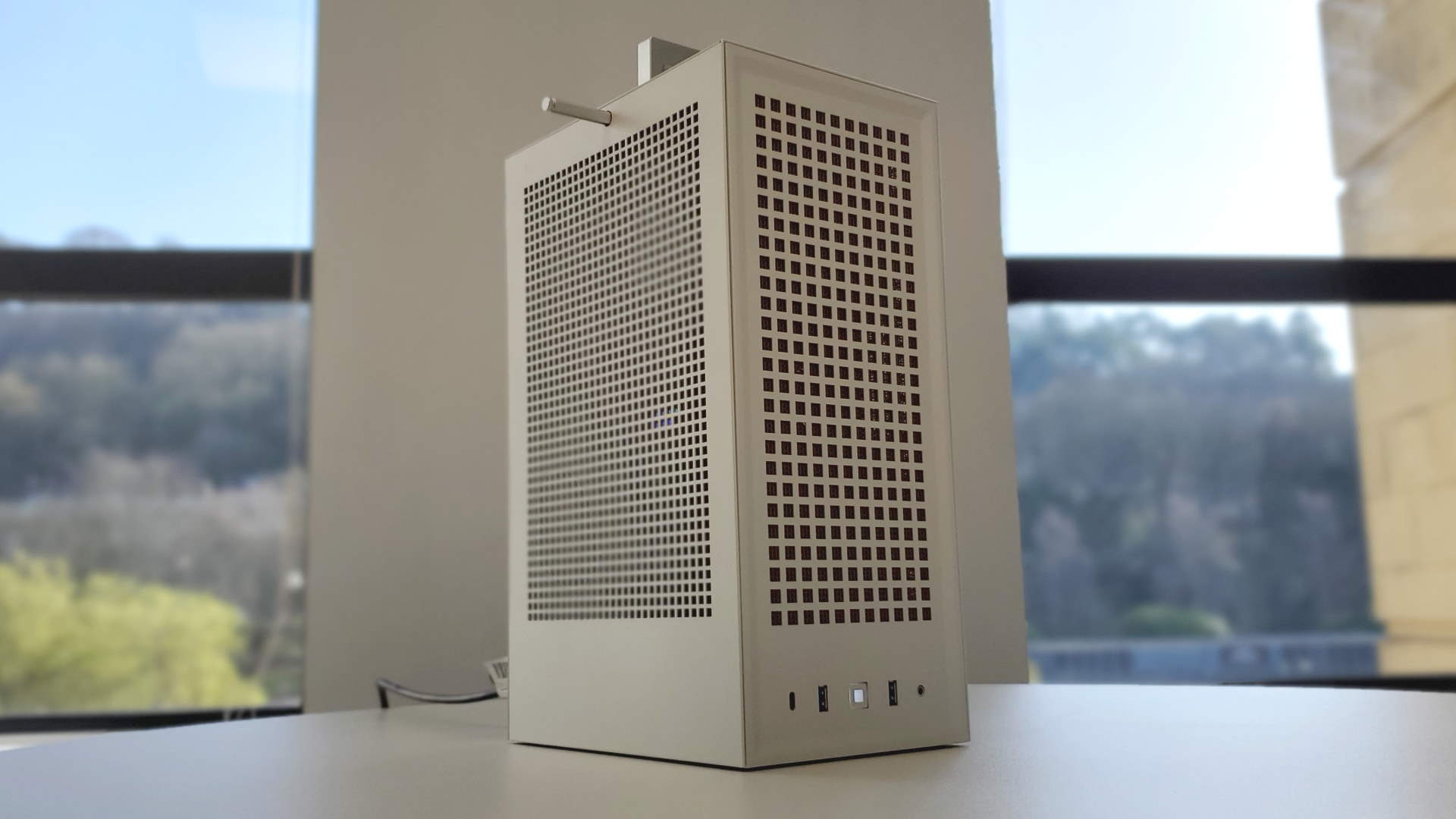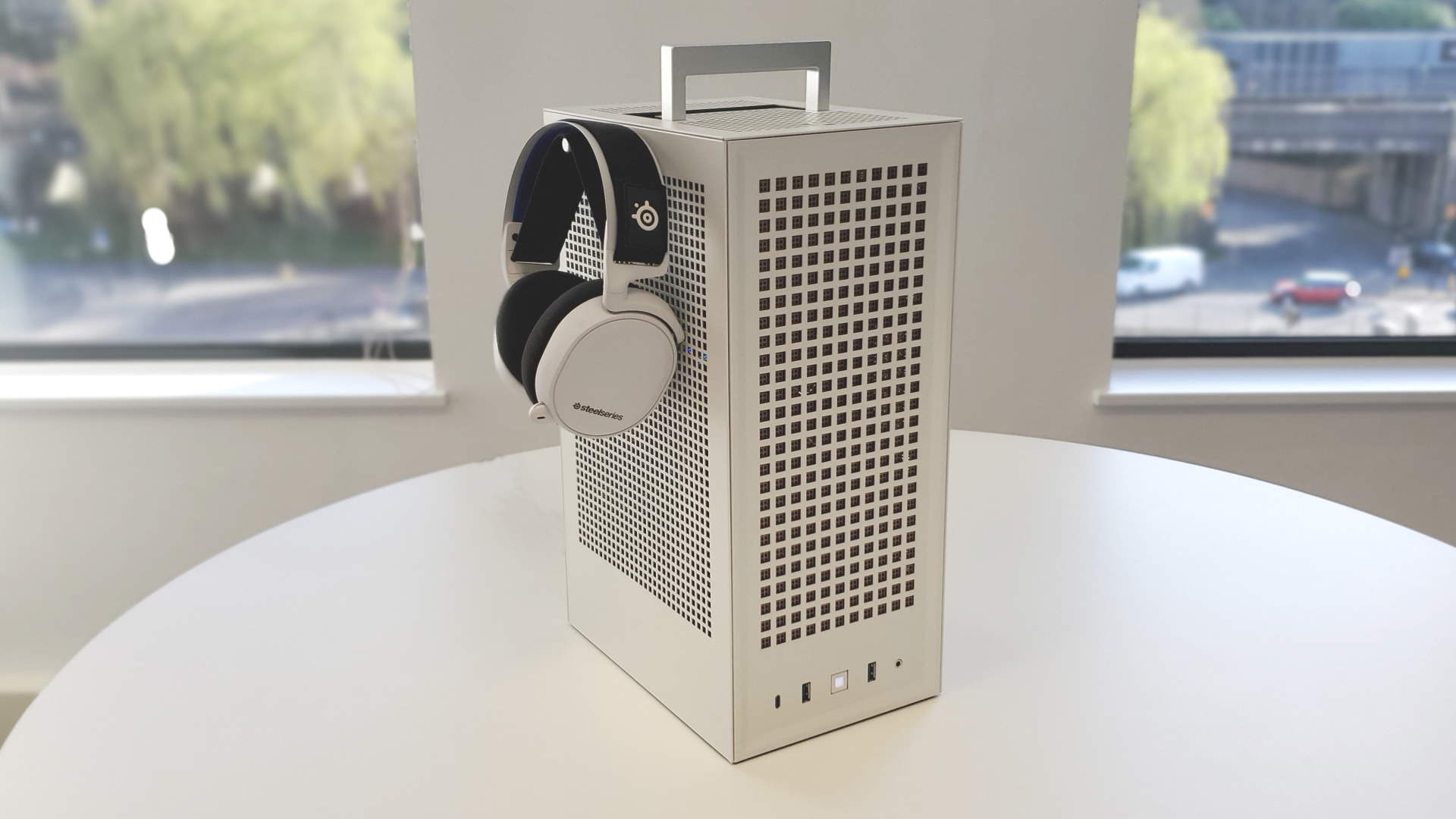Our Verdict
On first look it might seem just a cheaper option compared with NZXT's H1, but it's so much more than that, with smart design choices, huge options for builds, and y'know, a handle.
For
- Decent price
- With 700W PSU cabling is routed
- No GPU riser cable to worry about
- Will take a 280mm AIO
Against
- Feels a bit cramped to build into
- Not my favourite look
PC Gamer's got your back
There is something supremely industrial about the almost utilitarian design of the mostly metal Hyte Revolt 3 mini-ITX PC case. It doubles down on the angular, cuboid aesthetic with every facet of the external design being unashamedly sharp. Well, apart from the rounded, pop-out headphone holders, that is. And even now I still don't know if I like this pared back approach or find it just, well, basic.
What I do know, however, is that this is an excellent modern chassis to build your next Mini-ITX PC into, with support for a wide range of components, and no riser cable to worry about.
It's another wee chassis using the same sort of cubed vertical design popularised by the Xbox Series X, and turned into PC fire by the NZXT H1. Okay, okay, that's maybe a little unfair now that there is an NZXT H1 V2 revision that fixes the burning riser cable issue and improves on the otherwise excellent design.
The Hyte Revolt 3 is incredibly similar to the H1, but has marked differences where the two companies have gone in different directions with their internal design choices. The lack of riser cable is one, though that doesn't mean you're really any less restricted in terms of your GPU choice.

Motherboard support: Mini-ITX
Dimensions: 409 x 253 x 178 mm
Weight: 6.3 kg (inc. PSU)
GPU clearance: 335 x 58 mm
Radiator support: Up to 280 x 35 mm
Front I/O: 2x USB 3.2 Type-A, 1x USB 3.2 Type-C, 3.5 mm audio jack
PSU: 700W SFX 80 Plus Gold (optional)
Cooling: None
Warranty: 3 years (case)
Price: $130 | $250 with PSU | £199
Anything over 58mm thick isn't going to fit, but that still gives you a host of fat graphics cards to choose from, up to something so chonk as the Asus TUF RTX 3080. But eliminating that riser point of failure is handy, and the Revolt 3 still houses everything in more or less the same overall footprint even with the motherboard mounted perpendicular to the GPU.
One other benefit of this is that you can squeeze an entire 280mm AIO liquid CPU cooler into the build. Any off the peg chiller with a radiator under 35mm thick will fit, and you won't run into the same memory height restrictions the H1 has. Our Corsair Dominator DDR5 kit fit in just perfectly. What might be an issue is the 3.5-inch HDD bay next to the PSU, though it's got a mesh cut-out so even if your fans are pressed against it they'll still get some airflow.
With a low-profile air cooler, however, even a not-so-low air cooler in fact, you still have a lot of space to play with when picking your parts. That's handy, because the Revolt 3 can come as a completely barebones chassis, so there's none of the cable or pipe routing help the H1 design offers. It does give you free reign though on components, and there is still the option to pick it up with a 700W SFX PSU, too.
There is also the option to literally pick it up thanks to the angular, pop-out handle on top of the case. Which, honestly, is a bit of a pain to get out when you want to yet somehow annoyingly easy to activate when you don't.




As a barebones chassis it comes in at a very reasonable $130, but when you factor in the 700W PSU that leaps to $250. Initially I thought that was a bit steep, but it is literally just the price of a high-capacity SFX power supply these days. With the added bonus of knowing that it will fit just fine and with routing at least for the power wiring.
That also means it's considerably cheaper than the H1 V2, which is some $400, though does also mean you will have to find your own CPU cooler.
I'm not sure I love the overall boxy aesthetic, but there is a lot I do like about the Revolt 3
When it comes to the actual build process, however, I still favour the NZXT chassis. Creating mini PCs back-to-back with these two chassis really highlighted how much more of a pleasure it is getting your components into the H1. It's still a cramped build in the Revolt 3 even without a liquid cooler and radiator involved, most especially when I was trying to deal with the PSU and front panel cabling in around the DIMM slots.


You'd hope not to spend an age going in and out of your machine once built, however, so that becomes less of a concern over time. It's still simple for upgrades, though, with a tool-less access design and large cut-out behind the CPU on the motherboard tray.
I'm not sure I love the overall boxy aesthetic, but there is a lot I do like about the Revolt 3. It's not just a cheaper alternative to the NZXT H1 V2—though it most definitely is—there are other things it's got going for it, too. There's ample space for cooling, no worries about risers, and lots of GPU wiggle room, too. And it's right up there with the best mini-ITX chassis around.
On first look it might seem just a cheaper option compared with NZXT's H1, but it's so much more than that, with smart design choices, huge options for builds, and y'know, a handle.

Dave has been gaming since the days of Zaxxon and Lady Bug on the Colecovision, and code books for the Commodore Vic 20 (Death Race 2000!). He built his first gaming PC at the tender age of 16, and finally finished bug-fixing the Cyrix-based system around a year later. When he dropped it out of the window. He first started writing for Official PlayStation Magazine and Xbox World many decades ago, then moved onto PC Format full-time, then PC Gamer, TechRadar, and T3 among others. Now he's back, writing about the nightmarish graphics card market, CPUs with more cores than sense, gaming laptops hotter than the sun, and SSDs more capacious than a Cybertruck.


